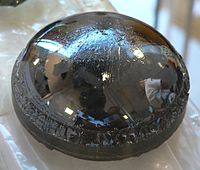
Photo from wikipedia
The hydride growth on metallic surface can cause material failure, which is a significant form of pitting corrosion. A new multiphase-field model is constructed to study the hydride corrosion kinetics,… Click to show full abstract
The hydride growth on metallic surface can cause material failure, which is a significant form of pitting corrosion. A new multiphase-field model is constructed to study the hydride corrosion kinetics, in which three order parameters are introduced to represent the passive film, hydride and metal phase, respectively. Coupling with hydrogen concentration field and elastic strain field, this model not only presents the growth of hydride and the rupture of passive film, but also reveals the hydrogen diffusion mechanism and the effect of strain energy on pitting corrosion process. The simulation shows the semi-ellipsoidal cerium hydride forms and grows near the passive film/cerium interface. During this process, the passive film on the upper side of the hydride is also hydrogenated or peeled off, resulting in faster hydrogen transport, which in turn promotes the growth of hydride. The formation of cerium hydride causes volume expansion, and the strain energy is mainly distributed around the hydride, which inhibits its growth. The present study contributes to understanding the formation mechanism of hydride corrosion at mesoscale, especially the pitting corrosion kinetics of rare earth metals.
Journal Title: Materials Research Express
Year Published: 2021
Link to full text (if available)
Share on Social Media: Sign Up to like & get
recommendations!